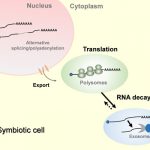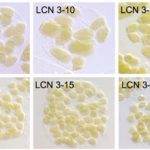Ray Parenchymal Cells Contribute to Lignification
In conifers such as Norway spruce (Picea abies), lignin is a major cell wall constituent of secondary xylem (wood), forming approximately 27% of the dry weight. Lignin enhances the structural stability of wood as well as water transport through it. Lignification encompasses  many steps, starting with the biosynthesis of monolignols in the cytosol and their transport across the plasma membrane. In the cell wall, monolignols are exposed to extracellular peroxidases and laccases, the enzymes initiating polymerization of lignin. But from where do these monolignols originate? Is monolignol biosynthesis in conifers a cell-autonomous process occurring in xylem tracheids, the main cell type in conifer wood, or do neighboring cells (i.e. ray parenchymal cells) contribute to the production of monolignols? To answer this question, Blokhina et al. (10.1104/pp.19.00743) used laser-capture microdissection to isolate parenchymal ray cells and upright tracheids from tangential cryosections of developing xylem of Norway spruce trees. The transcriptome analysis revealed that most of the shikimate and monolignol biosynthesis pathway-related genes were equally expressed in both cell types. Since transcript abundances are not always reflective of protein abundances, enzymatic activities and metabolite levels, single-cell metabolome analysis was conducted separately from developing ray cells and tracheids using picoliter pressure probe-electrospray ionization-mass spectrometry to investigate whether monolignol-related metabolites existed in developing ray cells. Both the transcriptomic and metabolomic data strongly suggest that developing ray cells contribute to lignification of cell walls of developing tracheids.
many steps, starting with the biosynthesis of monolignols in the cytosol and their transport across the plasma membrane. In the cell wall, monolignols are exposed to extracellular peroxidases and laccases, the enzymes initiating polymerization of lignin. But from where do these monolignols originate? Is monolignol biosynthesis in conifers a cell-autonomous process occurring in xylem tracheids, the main cell type in conifer wood, or do neighboring cells (i.e. ray parenchymal cells) contribute to the production of monolignols? To answer this question, Blokhina et al. (10.1104/pp.19.00743) used laser-capture microdissection to isolate parenchymal ray cells and upright tracheids from tangential cryosections of developing xylem of Norway spruce trees. The transcriptome analysis revealed that most of the shikimate and monolignol biosynthesis pathway-related genes were equally expressed in both cell types. Since transcript abundances are not always reflective of protein abundances, enzymatic activities and metabolite levels, single-cell metabolome analysis was conducted separately from developing ray cells and tracheids using picoliter pressure probe-electrospray ionization-mass spectrometry to investigate whether monolignol-related metabolites existed in developing ray cells. Both the transcriptomic and metabolomic data strongly suggest that developing ray cells contribute to lignification of cell walls of developing tracheids.



